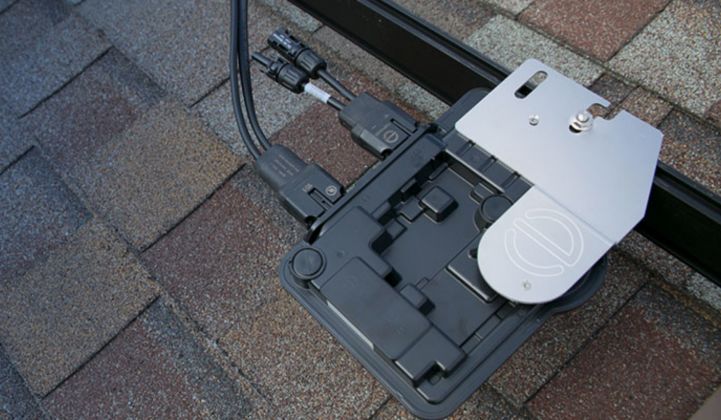Enphase on Tuesday reported growing revenue and profits for the second quarter of 2019, driven by increasing shipments of its latest generation of solar microinverters in North America and Europe, as well as consistent growth for its AC module products.
And the introduction of its solar inverter-battery home energy management system, central to its long-term plans, is still several quarters away.
The Petaluma, Calif.-based company reported a second-quarter profit of $10.2 million on revenue of $134.1 million, up from the first quarter’s net income of $2.8 million on revenue of $100.2 million. It's a major turnaround from its $3.74 million loss on revenue of $75.9 million in the second quarter of 2018.
“We had a pretty strong quarter,” CEO Badri Kothandaraman said on Tuesday’s earnings call, downplaying the company's third straight profitable quarter.
Shares of the Nasdaq-listed company surged 28 percent on Wednesday morning, to nearly $28 — having started the year below $5.
- Enphase shipped nearly 1.3 million microinverters, or 416 megawatts (DC), in the quarter. Its latest IQ 7 technology accounted for 98 percent of shipments.
- Non-GAAP gross margin was 34.1 percent, up from 33.5 percent in the first quarter of 2019.
- Enphase ended the quarter with $206 million in cash, up from $78.1 million at the end of the previous quarter, and generated $14.8 million in cash flows from operations.
- The company issued third-quarter guidance for revenue of $170 million to $180 million, GAAP and non-GAAP gross margin within 33 percent to 36 percent, and GAAP operating expenses between $28.5 million and $30.5 million.
In recent quarters, Enphase has been reclaiming share in the solar microinverter market it helped create. The company held a successful IPO in 2010, but more recently its dominance has been challenged by Israel-based solar microelectronics maker SolarEdge and incumbent string inverter makers. In 2016, the year in which the company’s losses peaked at $67.5 million, Enphase restructured, laid off workers and replaced founding CEO Paul Nahi with former COO Kothandaraman.
Centered around a technology revamp, the restructuring has helped Enphase claw back from the brink. It shrunk 2017 losses to $45.2 million on revenue of $286.2 million and 2018 losses to $11.62 million on revenue of $316 million. The first profitable quarter for the company came in Q4 2018, with net income of $709,000.
Enphase, along with many of its competitors, has struggled with an ongoing electronics components shortage for the past several quarters, forcing it to air-ship some critical components and eroding its gross margins. While demand continued to outstrip supply in the second quarter, the company is on track to increase its supply to about 2 million inverters by the fourth quarter of 2019, Kothandaraman said Tuesday.
News of note in the quarter included the first shipments of Enphase inverters from the Mexico factory of manufacturing partner Flex, which Enphase expects to ease costs associated with U.S. tariffs on products from Flex's manufacturing in China.
Enphase also saw particularly strong second-quarter revenue growth of 107 percent year-over-year in the U.S. market, where it no longer faces the specter of Chinese competitor Huawei introducing a microinverter product. Huawei's apparent departure from U.S. markets amid escalating trade tensions with the Trump administration has reduced pressure on Enphase and its chief rival in the panel-level microelectronics market, SolarEdge.
European revenue was also up 46 percent compared to the same quarter last year, driven by IQ 7’s advantages in solar markets with limits on rooftop space, Kothandaraman said.
Asia-Pacific revenue grew 29 percent from the previous quarter but was down 2 percent from the same quarter last year, as Enphase is “rebuilding our solar-storage teams in the region,” he said. Latin American revenue was down 7 percent from the previous quarter but up 27 percent from the same quarter in 2018, and the CEO said Enphase remains “bullish about opportunities” in the region.
Enphase’s AC modules — solar panels from partners including SunPower, Panasonic and Solaria with built-in microinverters — continue to gain traction, Kothandaraman added. Last month, the company hit the milestone of 500 U.S. solar installers using its modules.
As for Enphase’s energy storage and home energy management plan, Kothandaraman said “we expect storage to play a major role in our near-term revenue growth” through its Ensemble platform. That combination of battery, inverter, related switchgear and controls, plus a cloud-based software platform, anchors Enphase’s hopes of transforming from a microinverter company “to a home energy management systems company.”
Enphase expects to introduce Ensemble in the fourth quarter of 2019 and make it more broadly available in 2020.




